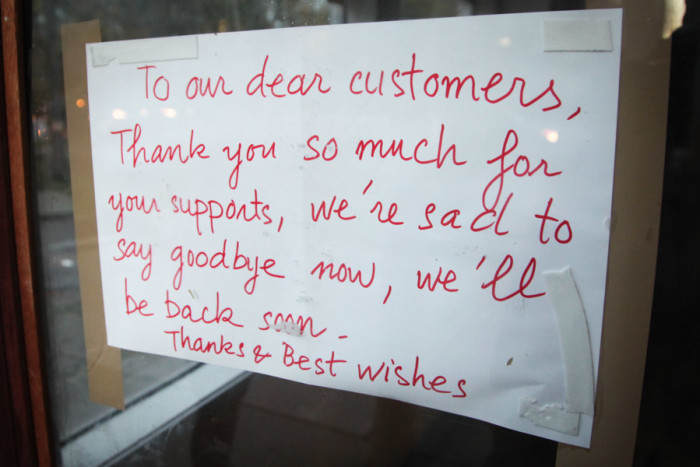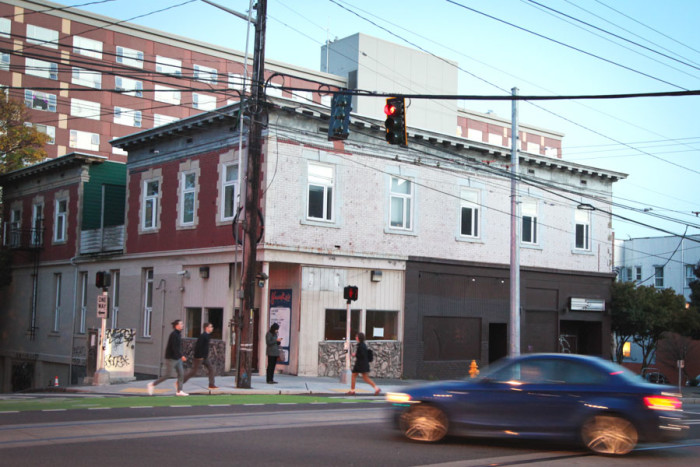
Yasuko Connor doesn’t really want to talk about why her teriyaki shop on Broadway closed after more than twenty years.
“Employees were not honest,” she said, “business was declining so I sold the building.”
Her business partner Danny Rubin says rising property values didn’t play a role in the decision to close up shop and sell.
“We owned that building for years,” her Rubin said. “We almost owned the whole block.”
But he says he’s seen other business owners around them on Capitol Hill struggle with rapid development and related cost increases.
“It’s true, small businesses are having a hard time,” he said. “Rents are pretty high. It’s just the demand.”
Yasuko’s joins a growing list of shuttered Seattle small businesses — many of them minority-owned — that once shaped the city’s diverse culture.
We dug into thousands of new property appraisals by the King County Tax Assessor and found a surprising trend: Double and even triple digit percentage increases in assessed value await hundreds of commercial property owners going into the next tax year.
It’s a positive sign for a growing city. But the huge year over year jump calls into question the pace of growth and whether “old Seattle” can keep up.
The properties with soaring market values house independent art galleries, mom and pop convenience stores and auto mechanics. Others have already turned into swanky restaurants and micro-housing complexes.
The county’s assessed value of the Yasuko’s building, for example, shot up by 129 percent this year.
Tre Maxie, King County’s Chief Deputy Assessor, said such assessments are based on the market, making them a good indicator of what’s happening in the city.
“We don’t direct the market, the market directs us,” Maxie said. “If the market is up 20 percent, [appraisals are] up 20 percent.”
For commercial properties, assessors usually use a model that estimates how much the property could be leased for on the open market (not how much the current tenants are paying). In some cases they’ll also look at the sale prices of comparable properties nearby.
Big changes in assessed value from year to year do have a direct impact as well. If a property’s assessed value increases 50 percent or 100 percent, as many did this year, the tax bill next year will increase substantially. Maxie is quick to point out we can’t know by exactly how much until the tax rate is set for the city, based on which levies pass, and some other factors.
But in the case of properties valued in the millions of dollars, the increase in tax bill could be in the tens of thousands of dollars. Property owners have to come up with that additional cash somewhere, often by raising rents on tenants or redeveloping — or selling the property altogether, as Connor and Rubin did with the Yasuko’s building.
But more often, big swings in county assessments are just a sign of changes to come, not the primary cause.
The map above shows more than 100 commercial properties in Seattle with the biggest percent increases in assessed value from 2014 to 2015.
The cluster of data points along Roosevelt Way, for instance, reflect skyrocketing property values in the area due to the light rail station planned to open in 2021.
Browse through the data points in your neighborhood and you’ll likely find a mix of buildings and businesses that have changed recently and ones that are probably about to.

Seattle’s growth is a circle — the demand drives the development, the development drives the appraisals and then you’re back to the demand, Rubin says.
“All what they’re building, that’s what’s driving it up,” he said. “People can pay it.”
Last week City Council Member Kshama Sawant announced a plan to protect small businesses, particularly those owned by women and minorities, from increasing lease rates and poor access to capital.
The state ban against regulating rent does not apply to commercial leases. So Sawant is looking to put commercial rent stabilization in effect in Seattle.
In the meantime, some longstanding businesses like Bill’s Off Broadway have struck deals with the developers to reopen in the new buildings that replaced their old locations.
Other business owners are turning to the landmark commission for help. Shorty’s Pinball Arcade was temporarily saved from demolition and planned conversion into a larger mixed-used building after the old building gained landmark status in October.
“It can turn into a bunch of Taco Bells and Burger Kings…”
When Elissa Pryor co-founded Spinnaker Bay Brewing about three years ago on Rainier Avenue South, she wanted to make a positive impact to revitalize the Hillman City neighborhood filled with vacant buildings.
Since the brewery opened, it has picked up the pieces shuttered blues clubs and other hangouts left behind.
The city’s changing landscape is “a really touchy subject,” Pryor said.
She misses the “little grandma houses” that dotted the streets, now replaced with boxy duplexes and micro-housing.
This year, the assessed value of the building that houses Spinnaker Bay went up by 58 percent, from $326,800 to $517,900.
Pryor and Janet Spindler, the other owner of Spinnaker Bay Brewing, say that’s fair — they’ve put a lot of work into the building. And they negotiated their lease with the building owner to keep them safe from swings in value and property taxes. Pryor said they don’t pay full market rate for the rent.
“But that is not true for the tattoo parlor, who might have to move out of the neighborhood because of that very reason,” she added.
Spindler said the neighborhood is at a tipping point.
“It can turn one of two ways: it can turn into a bunch of Taco Bells and Burger Kings and stuff like that, or it can turn into a bunch of cool privately owned businesses,” she said. “We’d rather have that than the alternative.
Bonnie Christiansen, director of commercial appraisers for King County says the real reason the county increased the value of Spinnaker Bay’s building was because of a past error. On physical inspection this year, they discovered there was much more square footage in the building than previously thought.
The county reports that it re-appraises every commercial property annually. But physical inspections are on a six year rotation. Many of the properties we looked at are seeing big changes all of the sudden, after staying flat for years.
20 small businesses with big jumps in property value in 2015:
- Union Bar — Hillman City
- Elliot Bay Bookstore — Capitol Hill
- Seattle Glassblowing Studio — Belltown
- Zaina Food, Drinks and Friends — Lake City
- Taste of India Restaurant — Roosevelt
- I Love Bento — Wedgewood
- Stoneway Electric — Fremont
- Kozue Japanese Restaurant — Wallingford
- Jones BBQ — West Seattle
- Café Petirosso — Capitol Hill
- Jacobson Terminals Marina — Ballard
- Spinnaker Bay Brewery — Hillman City
- Sahara Hookah Lounge — Lake City
- Plaid Pantry — University District
- Korean Tofu House — University District
- Varsity Inn Restaurant — Wallingford
- Kroll Map Company — Belltown
- American Dance Institute – Greenwood
- Laco Melza Ethiopian Restaurant — Central District
- Spic ‘n Span Cleaners — International District
Full data below
Christiansen had a similar explanation for the huge assessed value hike of the former warehouse on Capitol Hill that’s now home to the Elliott Bay Book Co. She said the $1.6 million increase was because, until this year county assessors hadn’t caught on to the building’s new use as a retail space — even though the bookstore moved in way back in 2010.
The King County Assessor’s office is generally understood to be well run. But in a moment of unprecedented growth, the status quo might not be good enough.
That’s the message of John Wilson, who is challenging incumbent County Assessor Lloyd Hara in this November’s election.
Wilson, who previously served as Hara’s deputy assessor has made housing affordability the key issue his campaign.
For Peter Aaron, owner of Elliott Bay Books, it comes down to who can afford to be where.
Aaron wonders whether the bookstore would be forced to relocate, cutback staff or make another hard decision if not for his long-term lease.
“Would we be able to afford our location? I don’t know… I would guess probably not, but that’s pure conjecture,” he said. “We’re fine, but 20 years from now when it comes time to renegotiate the lease, it’s going to be a whole different world.”
In his zip code, 98122, businesses are seeing millions of dollars added to their appraisals.
Café Petirosso on East Pike Street saw a 195 percent increase this year, and Laco Melza Ethiopian Restaurant, on East Jefferson Street, saw a 105 percent increase. Woven Art, a rug store in Pioneer Square, will reportedly close its doors due to rising rents and disruptions from nearby construction.
“It’s not friendly like it used to be… The city’s not as fun anymore.”
A Seattle institution and icon of Capitol Hill, Aaron’s bookstore is smashed in the middle the city’s explosive growth, littered with cranes and concrete mixers, and the city’s colorful fabric woven with businesses and people found nowhere else.
Aaron says he isn’t against development. The new construction came with pedestrians and dollars, benefitting his store and many others in the area. But despite its benefits, Aaron knows there’s a downside.
Through the growth, development and change in the city, Aaron said it’s important Seattle doesn’t demolish its diversity.
“My biggest concern, not just from a business point of view, but from a citizen point of view, is to make sure that you keep that balance of all income levels in the city,” he said.
For Yasuko Connor and Danny Rubin, it’s not the right time to look for a new location to reopen Yasuko’s Teriyaki. In spite of a hopeful handwritten sign posted in the window, they say the business will stay closed.
“It’s not friendly like it used to be a long time ago. The city’s not as fun anymore,” Rubin said. “The look of it is too modern. That look we used to have is gone, back when it was fun and friendly.”
Browse a sortable database of commercial properties with the biggest year-over-year increase in value from 2014-2015 (source: King County Dept. of Assessments):
Additional reporting by Alex Stonehill. Additional data analysis by Varisha Khan.


I don’t know. Los Angeles, Seattle, Portland, San Francisco, they’re all alike. Same politics. Same values. They all look alike, right down to the characterless cookie cutter buildings. Sort of like the McDonald’s of the urban sphere. Exactly the same appearance, exactly the same people, and all little boxes of ticky tacky that are not only just the same – but the inhabitants are exactly the same.
Same disgusting overpriced SROS marketed as micro-housing. Once upon a time one could rent a room in an SRO for four or five dollars a night, or less. Now one pays more than a thousand dollars a month for the same thing, renamed “microhousing.” The only difference is at least there were windows in the old SROS, even on the inside rooms because the buildings used to have airshafts.
What’s the difference between a flop house and microhousing? About a grand a month. And much, much happier developers.